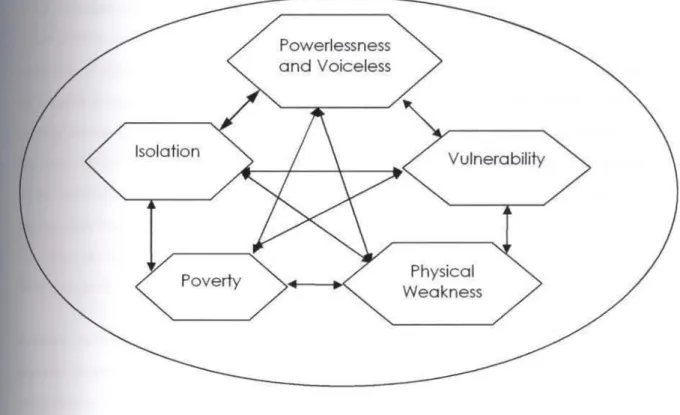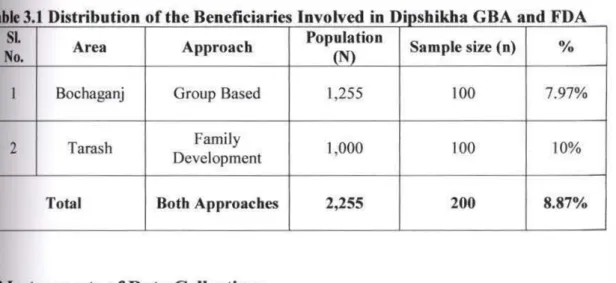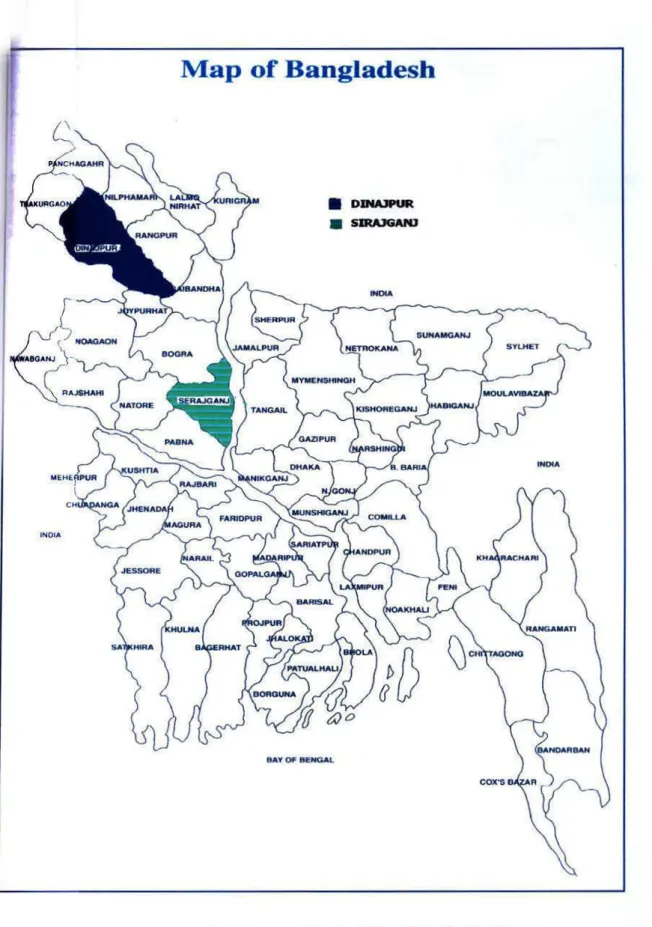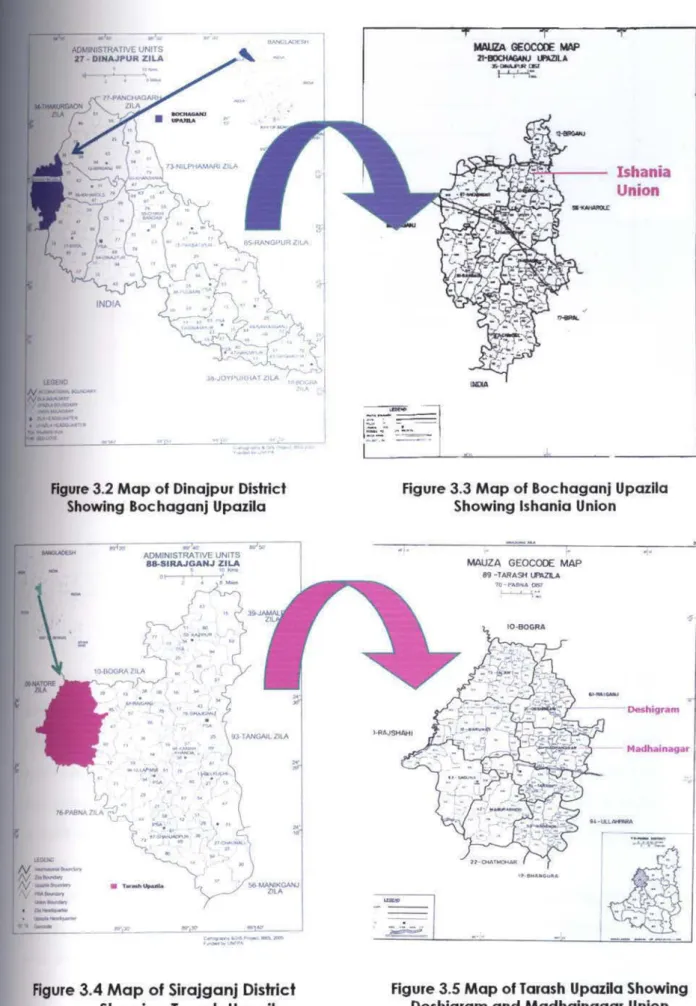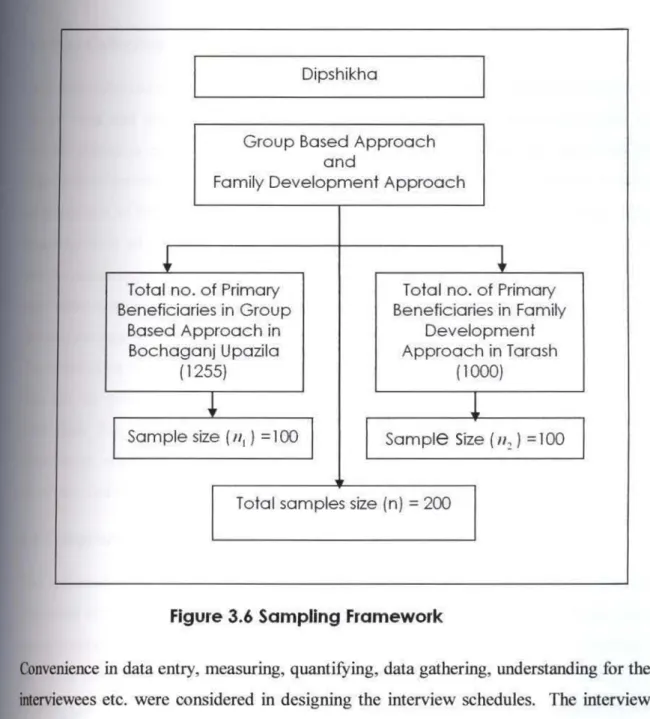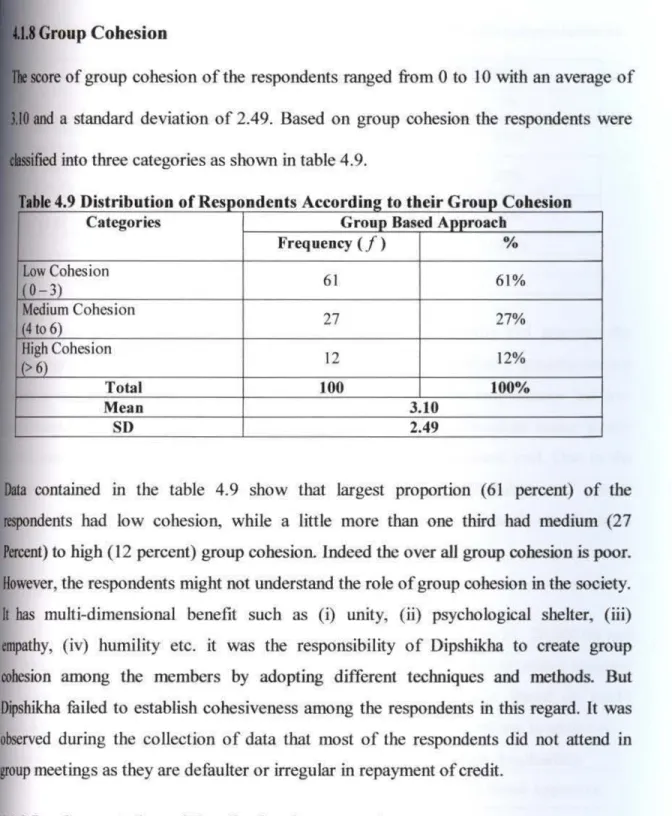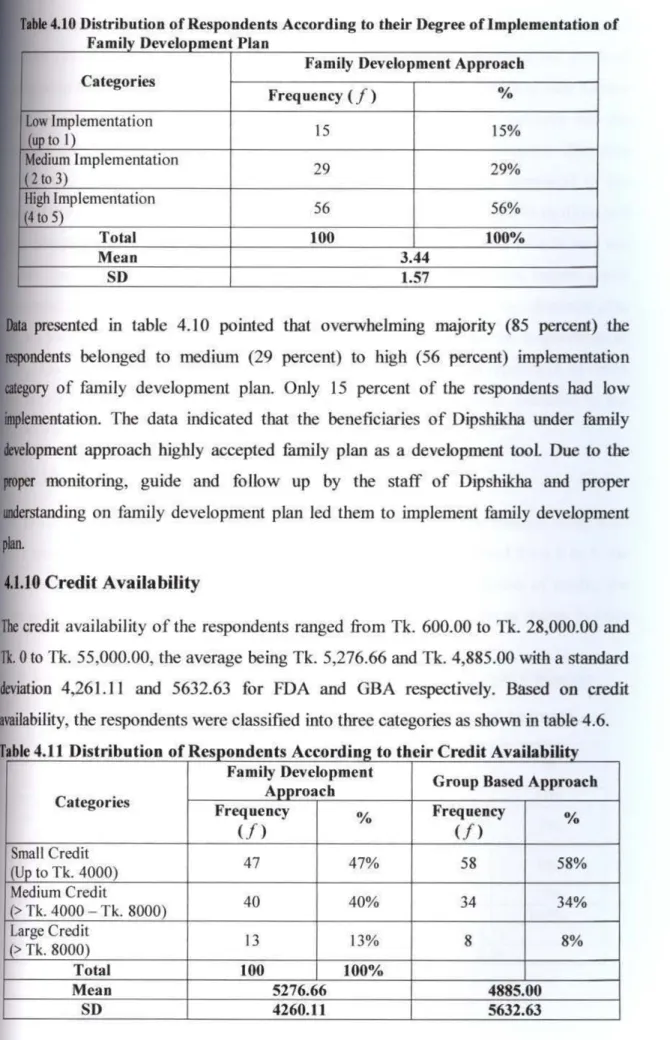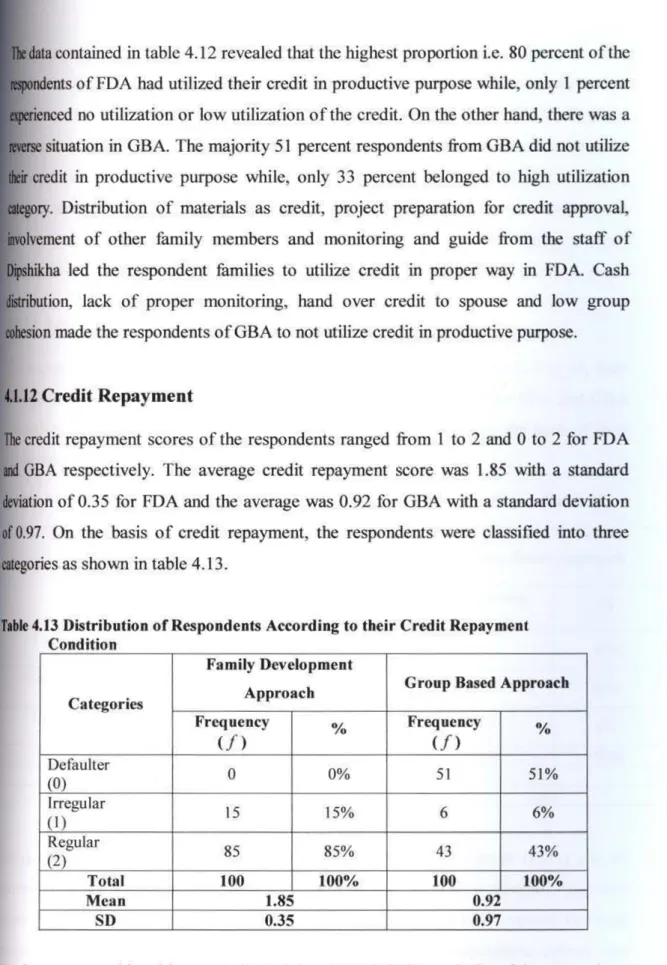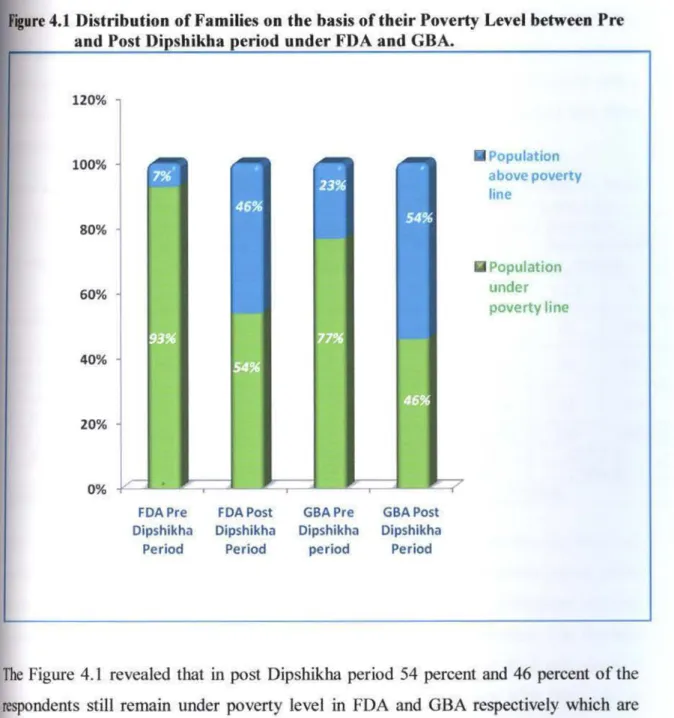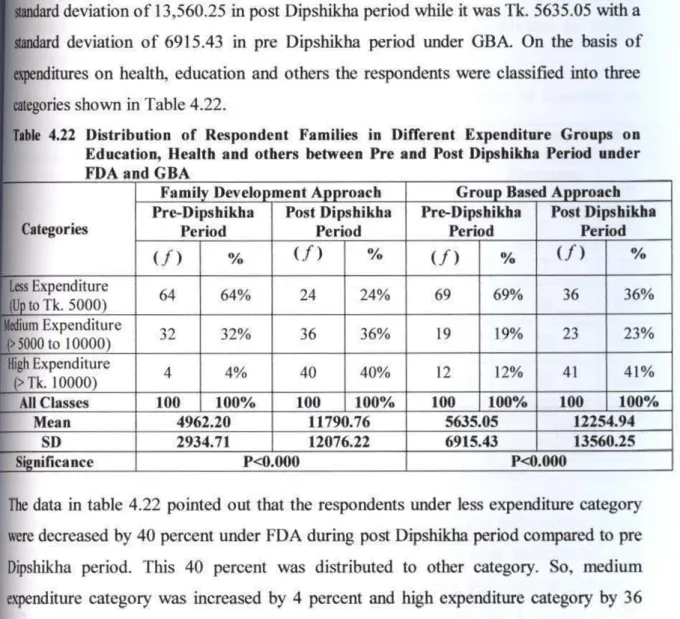June 2007
SHER-E-BANGAL AGRICULTURAL UNIVERSITY Dhaka-1207
DEPARTMENT OF AGRICULTURAL EXTENSION
&INFORMATION SYSTEM MD. MAHBUBUL ISLAM
Comparative Study of Family Development Approach and Group
Based Approach of Dipshikha on Poverty Reduction
(Professor Md. Shadat Ulla ) Chairman
(Professor Md. Rafiquel Islam) Co-supervisor
(Prof. Mohammad Hossain Bhuiyan) Supervisor
~
.. 0
Approved by
SEMESTER : JANUARY - JUNE, 2007 MASTER OF SCIENCE
IN
AGRICULTURAL EXTENSION & INFORMATION SYSTEM A Thesis
Submitted to the Faculty of Agriculture, Sher-e-Bangla Agricultural University, Dhaka,
in partial fulfillment of the requirements for the degree of
BY
MD. MAHBUBUL ISLAM
REGISTRATION NO.: 01839
Comparative Study of Family Development Approach and Group
Based Approach of Dlpshlkha on Poverty Reduction
~
.. 0
{Prof. Mohammad Hossain Bhulyan) Supervisor
Dated: , 7, '2... ~ Dhaka, Bangladesh
by
him.availed of during the course of this investigation has been duly acknowledged I further certify that such help or source of information, as has been diploma.
guidance. No part of the thesis has been submitted for any other degree or ISLAM, Roll No. 01839, Registration No. 01839 under my supervision and result of a piece of bona fide research work carried out by MD. MAHBUBUL SCIENCE in AGRICULTURAL EXTENSION & INFORMATION SYSTEM, embodies the Dhaka, in partial fulfillment of the requirements for the degree of MASTER OF submitted to the Faculty of Agriculture, Sher-e-Bangla Agricultural University, Approach and Group Based Approach of Dlpshikha on Poverty Reduction This is to certify that thesis entitled, Comparative Study of Family Development
CERTIFICATE
and Poverly-striken People
of Bangladesh
Beloved Parents
Dedicated to my
From the core of heart, the author desires humbly to express profound appreciation to Prof. M. Zahidul Haque, Department of Agricultural Extension & Information System, Associate Prof. Md. Sekender Ali, The author also expresses his profound gratefulness and gratitude to Mr.
Mofakh-Kharul Islam, Chairman, Dipshikba who provided constant cooperation, cordial support and sincere inspiration during the period of study.
The author desires to express his deepest sense of gratitude and endless gratefulness to Mr. Paul C. Tigga, Executive Director, Dipshikha, who allowed the author to undertake advanced study and took all inconveniences in his shoulder. Without his cordial support, cooperation and inspiration, the completion of study might not be possible.
The author wishes to express his illimitable gratitude and heartfelt thanks to bis most reverent teacher Prof. Md. Shadat Ulla, Chairman, Department of Agricultural Extension & Information System, Sher-e-Bangla Agricultural University, Dhaka for his invaluable teaching, cordial inspiration, dynamic support and cooperation from the very beginning of the study.
The author desires to express his heartfelt gratitude to his co-supervisor Prof.
Md. Rafiquel Islam, Department of Agricultural Extension & Information System, Sher-e-Bangla Agricultural University, Dhaka for his cordial inspiration, keen interest and continuous support and cooperation in all respects in preparation of the thesis.
The author is delighted to express his deepest sense of gratitude and sincere appreciation to his supervisor Prof. Mohammad Hossain Bhuiyan of 'Department of Agricultural Extension & Information System' and Director, Outreach Programme, Sher-e-Bangla Agricultural University, Dhaka for his keen interest, noble guidance, valuable suggestions, constructive criticism, affectionate feelings, continuous stimulation and encouragement throughout the study, without which the study might not have completed.
to express his gratefulness and praise to the mesh beneficial and merciful Allah who enabled the author in handling related issues at different stages of conduction of this research work.
ACKNOWLEDGEMENT
1.4-l 6 16 17 17-19
14 1-3 3-5
5 6-7
6 6-7 7-8 9-13 xv xiv xiv
XIII
x-xiii i-ii iii-ix PAGE NO.
fiiil
Concept of Poverty, Poverty Line, Absolute and Relative Poverty and Participation in Poverty Alleviation Activities by the Target beneficiaries
Concept of Poverty Poverty Line
Absolute and Relative Poverty
Studies Relating to Participation in Poverty Alleviation Activities
2.1.t 2.1.2 2.1.3 2.1.4 2.1
CHAPTER
2
REVIEW OF LITERATURE General background Statement of the problem Objective of the studyAssumptions and Limitations of the study Assumptions of the study
Limitations of the study Hypotheses of the Study De fin it ion of important terms I.I
11 IJ
1.4 1.4.1 1.4.2 1.5 1.6
CHAPTER 1 INTRODUCTION
ACKNOWLEDGEMENT TABLE OF CONTENTS LIST OF TABLES LIST OF FIGURES LIST OF APPENDICES LIST OF ABBREV LA TIONS ABSTRACT
TITLE
LIST OF CONTANTS
CHAPTER
Changes in annual expenditures for food and nutrition 34
3.6.1.3 Changes in annual expenditures for health, education and other 34-35
[ivl
27-28 28 28-31
32 32 32-48
33 34 Locale of the study
Population and Sampling of the study Instruments of data collection
Data collection Compilation of data
Selection of variables of the study Measurement of Dependent variables Changes in annual income
~HAPTER 3 METHODOLOGY
Annual Income and Poverty Reduction 21-22
Family savings and Poverty Reduction 22
Implementation of Family Development Plan and Poverty 22 Reduction
Group Cohesion and Poverty Reduction 22
Credit Availability and Poverty Reduction 23
Utilization of Credit and Poverty Reduction 23-24
Repayment of Credit and Poverty Reduction 24
Acceptance of Loan Received Conditions and Poverty 24 Reduction
Training Exposure and Poverty Reduction 24
Attitude towards Dipshikha and Poverty Reduction 24-25
Conceptual Framework of the Study 25-26
19 20 20 21 21 19-25 Studies relating to the Poverty Reduction and the Selected
Characteristics of the Target Beneficiaries Involvement with NGO and Poverty Reduction Age and Poverty Reduction
Education and Poverty Reduction Family size and Poverty Reduction Fann size and Poverty Reduction
[v]
3.6.1.4 Changes in land assets 35
3.6.1.5 Changes in productive assets other than land 35-36
3.6.1.6 Changes in non-productive assets 36
3.6.1.7 Changes in housing condition 36-37
3.6.1.8 Changes in drinking water source 37
3.6.1.9 Changes in sanitation 38
3.6.1.10 Changes in awareness on health issues 38
3.6.1.11 Changes in awareness on social issues 39
3.6.1.12 Changes in women empowerment 39
3.6. l.13 Total changes in socio economic condition 40-41
3.6.2 Measurement of Poverty 41
3.6.2.1 Head Count poverty measurement 42
3.6.2.2 Poverty Gap 42
3.6.2.3 Square poverty gap 42-43
3.6.3 Measurement of Independent variables for FDA and GBA 43
3.6.3.l Involvement with Dipshikha 43
3.6.3.2 Age 43
3.6.3.3 Education 43-44
3.6.3.4 Family Size 44
3.6.3.5 Fann size 44
3.6.3.6 Annual Income 44
3.6.3.7 Family savings 45
3.6.3.8 Group cohesion 45
3.6.3.9 Implementation of family development plan 45
3.6.3.10 Credit availability 45
3.6.3.11 Utilization of credit
46
3.6.3.12 Repayment of credit 46
3.6.3.13 Acceptance of loan received condition 46-47
3.6.3.14 Training exposure 47
3.6.3.15 Attitude towards Dipshikha 47-48
3.7 Data analysis 48
65-67 67-70 70-72 73-75 75-77 78-80 80-82 82-85 85-87 87-89
49 50-51 51-52 52-53 53-54 54-55 55-56 56-57
58 58-59 59-60 60-61 61-62 62-63
63 64 64-65 Selected characteristics of Dipsh ikha respondents
Involvement with Dipshikha
Age Education Family Size Farm Size Annual Income Family savings Group cohesion
Implementation of family development plan Credit Availability
Utilization of Credit Credit repayment
Acceptance of loan received condition Training exposure
Attitude towards Dipshikha
Extent of effectiveness of Dipshikha (i)group based approach and (ii) family development approach towards poverty reduction
Changes in annual income
Beneficiaries according to poverty line by income Changes in annual expenditures for food and nutrition
Changes in annual expenditures for health, education and other Changes in land assets
Changes in productive assets other than land Changes in non-productive assets
Changes in housing condition Changes in drinking water source Changes in sanitation
4.2.1 4.2. I.I 4.2.2 4.2.3 4.2.4 4.2.5 4.2.6 4.2.7 4.2.8 4.2.9
4.1 4.1. l 4.1.2 4.1.3 4.1.4 4.1.5 4.1.6 4.1.7 4.1.8 4.1.9 4.1.10 4.1.11 4.1.12 4.1.13 4.1.14 4.1.15 4.2
CHAPTER 4 FINDINGS AND DISCUSSION
109 109
109-110 110
110 J J 0-111 [vii]
Selected characteristics of the respondents Involvement with Dipshikha
Age Education Family Size 5.1.
5.1.1 5.1.2 5.J.3 5.1.4
CHAPTER 5 SUMMARY, CONCLUSION & RECOMMANDATIONS
5 Summary
Dipshikha towards poverty reduction.
4.3.2.1 Implementation of family development plan 105
4.3.2.2 Involvement with Dipshikha 105-106
4.3.2.3 Savings of the family 106
4.2.3.4 Credit availability 106-107
4.3.2.5 Acceptance ofloan received condition 107
4.3.2.6 Family size 107-108
101 101-102
102 102-105
99-101 98-99 90-92 92-94 94-96 97-98 Changes in awareness on health issues
Changes in awareness on social issues Changes in women empowerment
The extent of effectiveness of family development approach and group based approach of Dipshikha on socio economic condition of respondent families
Contributions of selected characteristics of the respondents to the effectiveness of Dipshikha Group Based Approach and Family Development Approach
Contribution of selected characteristics of the respondents to
the extent of effectiveness of group based approach of
Dipshikha towards poverty reduction Utilization of credit
Annual income
Altitude towards Dipshikha
Contribution of selected characteristics of the respondents to the extent of effectiveness of family development approach of 4.3.1.1
4.3. J .2 4.3.1.3 4.3.2
4.3. I 4.3
4.2.10
4.2.11 4.2.12 4.2.13
120 114-115
115 115
116 1 J6
117 117 117-118
118 118-119
119 119
119-120 120 1 1 I 11 J
111-112 112 112 112 113 113 113-114
114 114 114
[ viii]
Fann Size Annual Income Family savings Group cohesion
Implementation of family development plan Credit Availability
Utilization of Credit Credit repayment
Acceptance of loan received condition Training exposure
Attitude towards Dipshikha
Extent of effectiveness of Dipshikha (i) Group based Approach and (ii) Family Development Approach towards Poverty Reduction
Changes in annual income
Beneficiaries according to poverty line by income Changes in annual expenditures for food and nutrition
Changes in annual expenditures for health, education and other Changes in land assets
Changes in productive assets other than land Changes in non-productive assets
Changes in housing condition Changes in drinking water source Changes in sanitation
Changes in awareness on health issues Changes in awareness on social issues Changes in women empowerment
The extent of effectiveness of family development approach and group based approach of Dipshikha on socio-economic condition of respondent families
Contributions of selected characteristics of the respondents to the effectiveness of Dipshikha Group Based Approach and 5.4
5.2.1 5.2.1. I 5.2.2 5.2.3 5.2.4 5.2.5 5.2.6 5.2.7 5.2.8 5.2.9 5.2.10 5.2.11 5.2.12 5.3
5.1 .5
5.J.6 5.1.7 5.1.8 5.1.9 5.1.10 5.1.11 5.1.12 5.1.13 5.l.14 5.1.15 5.2
[ix]
BIBLIOGR..WHY
131- J34
Family Development Approach
Contribution of selected characteristics of the respondents to 121 the extent of effectiveness of group based approach of
Dipshikha towards poverty reduction
Contribution of selected characteristics of the respondents to 121-122 the extent of effectiveness of family development approach of
Dipshikha towards poverty reduction
Summery of Hypotheses Testing 122
Conclusion J 23-126
Recommendations 127
Recommendations for policy implication 127-129
Recommendations for further research
129-130
[x]
64 Distribution of Respondents According to their Training 63
Exposure
Distribution of Respondents According to their Attitude towards Dipshikha
Distribution of the Beneficiaries Involved in Dipshikha GBA 28
and
FDASalient features of the selected characteristics of the 50 respondents
Distribution of Respondents According to their Involvement 51 with Dipshikha
Distribution of Respondents According to their Age. 52 Distribution of Respondents According to their Education 53 Level.
Distribution of Respondents According to their Family Size 54 Distribution of Respondents According to their Parm size 55 Distribution of Respondents According to their Annual Income 56 Distribution of Respondents According to their Savings 57 Accumulation
Distribution of Respondents According to their Group 58 Cohesion
Distribution of Respondents According to their Degree of 59 Implementation of Family Development Plan
Distribution of Respondents According to their Credit 59 Availability
Distribution of Respondents According to their Degree of 60 Credit Utilization
Distribution of Respondents According to their Credit 61 Repayment Condition
Distribution of Respondents According to their Acceptance of 62 Loan Received Condition.
LIST OF TABLES
81
80 79 78
77
76 74
73 72 71
68 66
65
rxi]
Distribution of Respondent Families in Different Annual Income Groups between Pre and Post Dipsh ikha Period under FDA and GBA.
Salient Features on the Effectiveness of FDA and GBA of Dipshikha on Income
Distribution of Respondent Families on the basis of Square Poverty Gap between Pre and Post Dipshikha Period under FDA and GBA
Distribution of Respondent Families in Different Expenditure Groups on Food and Nutrition between Pre and Post Dipshikha Period under FDA and GBA
Salient Features on the Effectiveness of FDA and GBA of Dipshikha on Expenditures of Food and Nutrition
Distribution of Respondent Families in Different Expenditure Groups on Education, Health and others between Pre and Post Dipshikha Period under FDA and GBA
Salient Features on the Effectiveness or FDA and GBA or Dipshikha on Expenditures of Health, Education and others Distribution of Respondent Families in Different Land Holding Groups between Pre and Post Dipshikha Period under FDA and GBA
Salient Features on the Effectiveness of FDA and GBA of Dipshikha on Land Assets
Distribution of Respondent Families in Different Productive Assets Holding Groups between Pre and Post Dipshikha Period under FDA and GBA
Salient Features on the Effectiveness of FDA and GBA of Dipshikha on Productive Assets other than Land
Distribution of Respondent Families in Different Non- Productive Assets Holding Groups between Pre and Post Dipshikha Period under FDA and GBA
Salient Features on the Effectiveness of FDA and GBA of 4.29
4.28 4.27 4.26 4.25 4.24 4.23
412
4.21 4.20 4.19 4.18 4.1797 96
fxii]
Empowerment Groups between Pre and Post Dipshikha Period under FDA and GBA
Salient Features on the Effectiveness of FDA and OBA of Dipshikha on Women Empowerment
Salient Features on the Effectiveness of FDA and GBA of 4.42
4.41
Dipshikha Period under FDA and GBA
4.39 Salient Features on the Effectiveness of FDA and GBA of 93 Dipshikha on Social Awareness
4.40 Distribution of Respondent Families in Different 95
92
9190
89 8886
85
84
83 Dipshikha on Non-Productive Assets
Distribution of Respondent Families in Different House Holding Groups between Pre and Post Dipshikha Period under FDA and GBA
Salient Features on the Effectiveness of FDA and GBA of Dipshikha on Housing Condition
Distribution of Respondent Families according to their Drinking Water Sources Between Pre and Post Dipshikha Period under FDA and GBA
Salient Features on the Effectiveness of FDA and GBA of Dipshikha on Drinking Water Sources
Distribution of Respondent Families according to their Sanitation Condition between Pre and Post Dipshikha Period under FDA and OBA
Salient Features on the Effectiveness of FDA and GBA of Dipshik:ha on Sanitation Condition
Distribution of Respondent Families according to their Awareness on Health Issues Between Pre and Post Dipshikha Period under FDA and GBA
Salient Features on the Effectiveness of FDA and GBA of Dipshikha on Health Awareness
Distribution of Respondent Families according to their Awareness on Different Social Issues Between Pre and Post 4.38
4.37
4.36 4.35 4.344.33
4.32 4.3 l 4.30
LIST Of FIGURES
2.1 A typical form of Rural Poverty (Chambers, 1983) 16
2.2 Conceptual Framework of the Study 26
3.1 Map of Bangladesh showing the study area 29 3.2 Map of Dinajpur district showing Bochaganj upazila 30 3.3 Map of Bochaganj upazila Showing lshania Union 30 3.4 Map of Sirajganj district showing tarash upazila 30 3.5 Map of tarash upazila Showing Deshigram and Madhainagar 30
Union
3.6 Sampling Framework 31
4.1 Distribution of Families on the basis of their Poverty Level 70 between Pre and Post Dipshikha period under FDA and GBA
4.2
A comparative distributions of respondents according to the 98 effectiveness of FDA and GBA4.44 104
100 Dipshikha
Summery of Step-wise Multiple Regression Analysis of the Respondents' Fourteen Selected Independent Variables with extent of effectiveness of GBA by using Linear Step-wise Technique
Summery of Step-wise Multiple Regression Analysis of the Respondents' Fourteen Selected lndependent Variables with the extent of effectiveness of FDA by using Linear Step-wise Technique
4.43
[xiv]
us
ac FAO FDA FGT FMMR GBA
GNP HC
NGO
PG SD SMR
SPG
ha
et al.
Analysis of Variance
Bangladesh Bureau of Statistics and other
Food and Agricultural Organization Family Development Approach Foster-Greer-Thorbecke Index Full Method of Multiple Regressions Group Based Approach
Gross National Product Head Count
Non-Government Organization Poverty Gap
Standard Deviation
Step wise Multiple Regression Square Poverty Gap
Hector Acre
United States ANOVA
BBS
ABBREVIATIONS AND ACRONYMS
Page No
APPENDIX-A Interview Schedule I-XI
APPENDIX-B Square Poverty Gap (GBA) XIl-XV
APPENDIX-C Square Poverty Gap (FDA) XVI-XIX
APPENDIX-D Paired sample t - test (GBA)
xx
APPENDIX-£ Paired sample t- test (FDA) XXI
APPENDIX-F Correlation Matrix (GBA)
xxn
APPENOIX-G Correlation Matrix (FDA) XX III
APPENDIX- H Short Profile of Dipshikha XXIV-XXVlll
List of Appendix
[xv]
Social well beings conditions of the respondents namely housing condition, sanitation condition, access of safe drinking water, knowledge on hea Ith and social issues and women empowerment situation were improved significantly as well under both the approaches after involvement with Dipshikha.
The findings revealed that 27%, 63% and I 0% of the respondents had low, medium and high socio economic changes respectively after involvement with Dipshikha under FDA while, 27%, 68% and 5% had low, medium and high changes respectively in GBA. The independent sample t-
test showed that there was no difference between the effectiveness of FDA and GBA towards poverty reduction. But the findings showed that FDA has more potentials than GBA towards poverty reduction in terms of time, credit utilization, credit repayment, savings accumulation, training exposure, use of safe drinking water and sanitary latrine, awareness on health etc.
Implementation of family development plan. involvement with Dipshikha, savings of the family, credit availability and acceptance of loan received condition had positive contribution and family size had negative contribution to the effectiveness of FDA of Dipshikha. Utilization of credit, annual income and attitude towards Dipshikha had positive contribution to the extent of effectiveness of G BA of Dipshikha.
Non-Governmental Organizations (NGOs) are well-known in Bangladesh for their innovative approaches. Dipshikha, an NGO, working for the resource poor people in order to reduce poverty specially in the northern part of Bangladesh. It has been working through two approaches namely (i) Family Development Approach and (ii) Group Based Approach. In the study attempts were made to determine the extent of effectiveness of family development approach (FDA) and group based approach (GBA) of Dipshikha towards poverty reduction. The effectiveness were measured by computing the changes in annual income, expenditure for food and nutrition, expenditure for health, education and others, land assets, productive assets other than land, non-productive assets, housing condition, drinking water sources, sanitation conditions, between before and after involvement with Dipshikha under both the approaches. Some of selected characteristics of the respondents and their contribution to the effectiveness of family development approach and group based approach were determined and described as well. Data were collected from early October to early November, 2006.
The findings of the study indicated that the economical condition of Dipshikha beneficiaries under both the approaches had improved significantly after involvement with Dipshikha in relation with annual income, food and non-food expenditures, productive and non-productive assets. The Head Count (HC) method pointed out that the poverty level reduced significantly after involvement with Dipshikha under both the approaches. Poverty was reduced by 39% from 93%
in FDA and 31 % from 77% in G BA. Although, the Foster-Greer-Thorbecke (FGT) index showed that 51 % of the respondents from FDA and 43% from GBA were stiU remain under upper poverty line in terms of income.
Comparative Study of Family Development Approach and Group Based Approach of Dipshikha towards Poverty Reduction
By
MD. MAHBUBUL ISLAM
ABSTRACT
Dipshikha - ''Non formal Education, Training and Research Society for Village Development" was initiated in 1978 by a group of social workers, teachers and youths in the viJlage of Rudrapur, Upazila Birol, District Dinajpur. It was registered with the Social Welfare Department in 1984 and Foreign Donation Ordinance in 1985. Dipshikha A large number of NGOs including Dipshikha are working in Bangladesh in order to develop the socio-economic condition of the poor. The NGOs and international organizations have implemented different sorts of poverty reducing programmes since mid-seventies. The NGOs are known worldwide for their innovative approaches. Many successful models in poverty reduction, microfinance, non-formal education and primary health care are developed by different NGOs.
Bangladesh has made considerable development in reducing poverty and improving the lives of its people within only a little over three decades as an independent country.
However, about 40% of its population of 141.8 million still lives below poverty level (World Bank, 2007) as measured by income, consumption and ability to meet basic human needs. The average per capita income of its population is only US$ 470 while the average per capita income of South Asia is US$ 590 (World Bank, 2007). Poverty means hunger, lack of assets - such as - land or savings and extreme vulnerability to shocks due to economic downturns, family illness or natural disasters. It means poor access to basic services and being unable to send children to school and often needing them to work instead. Poor people of Bangladesh tend to have low levels of education (44.9%, World Bank, 2002) and limited access to land and hold low paying, physically demanding, and socially unattractive occupations like casual wage labour. In both urban and rural areas, the poor lack of access to modem facilities and services and they also tend to live in inferior quality houses. In this situation poverty has become as a vital issue for the government, Non Governmental Organizations (NGOs) and the donor agencies as well.
The NGOs hand in hand with government have been implementing a wide range of development activities in order to develop socio economic condition of the poor.
1.1 General Background
CHAPTER I
Introduction
Dipshikha has long experience in rural development activities through Group Based Approach. It believes in and emphasizes on self-respect and absolute human dignity. It further believes in the total development of the person i.e. human, social, cultural, economical, spiritual and political. To achieve self-reliance of individual through group activities Dipshikha found that group approach could not respond to develop the entire family of the group members. Ullah and Routray (2003) stated in their book "NGOs and Development- Alleviating Rural Poverty in Bangladesh" that today the group based approach seems to limit the magnitude of contribution of the NGO programmes has to improve poverty situation. Dipshikha experienced that the whole system is now operating on the basis of individual liabilities.
Like other NGO, Dipshikha initiated their work through Group Based Approach (GBA) which targets mostly the women and one person from each poor family. In Bangladesh women are targeted because they are more available, more likely to repay on time the credit, more flexible and patient than men and cheaper to service. In GBA, Dipshikha developed a group consisting of 20 - 25 poor women in every village to promote unity and solidarity for economic emancipation as well as to get rid of social injustice. All the interventions from Dipshikha including credit activities were provided through group for its member only. Other family members are not allowed to get any intervention from Dipshikha. Another aspect to form group is to ensure effective credit repayment. The group mechanism transfers risks of non repayment from the programme to the group itself. Peer monitoring from the group members for credit repayment reduced the cost of transaction and allows for successful implementation of credit intervention through group liabilities.
was started in a simple and modest village Rudrapur, Dinajpur and gradually its activities were expanded into 13 Upazilas of 4 districts in northern Bangladesh during last 20 years. It is working now with about 22,000 beneficiary families with envisions "A poverty free, just and peaceful society". It believes in Integrated Development Approach, which is essentially needed to reduce the rural poverty of Bangladesh that includes formational education both for children and adults, appropriate agriculture, hygiene, sanitation, skills promotion and supports for income generation activities.
A
large number of Non-Governmental Organizations are working now
inBangladesh to fight
against povertythrough different approaches. In
early seventies,the NGOs came forward to assist the war devastated people with the task of relief and rehabilitation.
Lately in mid
seventies, they switched over their activities to sustainable developmentthrough a new approach known as "target group" approach by organized groups of poor people specially women in the
rural areas. NGOsorganized the poor people into small groups
atthe village level, arranged adult literacy programmes, provide necessary training and arranged regular discussion on different social issues.
Credit was disbursed among the membersto develop their income generation activities (Mustafa, et al, 1996).
The poor people specially women and children brought under NGOS' health activities.
Still now, more than
22,000 NGOs are working through this approach for elimination of rural poverty. But the incidence of rural poverty in Bangladesh ismuch higher
compared1.2 Statement of the Problem
In
this research, the researcher tried to find out theperformance of Dipshikha
activitiesthrough GBA and FDA
whichmay provide a valuable guideline for
theresearchers, planners, policy makers of Government and
Non-government organizations forprogramme development in order to reduce poverty.
On the
basis of their field
experiences, Dipshikha has developed Family Development Approach (FDA)in
2002 in order toimprove the livelihood
of poor familiesmore
intensively and
scientifically. Family asa social unit is considered to
bethe center of all
development
efforts.All members of the family are brought as stakeholders of the
development initiatives
in thisapproach. Dipshikha thinks that
all grown up potentialfamily members should take part
in economic and social development of the family.In
FDA,the member families prepare their five years development plan on the basis of their
problems,
resourcesand opportunities. Dipshikha facilitate the member families to
achieve their development plan. Moreover, this plan helps the member families to use the
support from Dipshikha effectivelyby appropriate person from the family. Further the
loans are issued under this system only when the individual family can contribute 20% of
the total cost of the proposed activities and repay their loans after getting income from
the specific activities. Member
families can use their savingsto invest in their
development activities.
er What are the personal characteristics of the rural poor and who are involved with Dipshikha activities through GBA and FDA?
er What are the selected personal characteristics of rural poor which contribute to extend of effectiveness of Dipshikha activities through GBA and FDA?
Cir What changes to the poor families are made by the intervention of Dipshikha through GBA and FDA in relation to annual income, food expenditures, non-food expenditures, land assets, productive and non-productive assets, housing conditions, water and sanitation conditions, awareness on social and health issues and women empowerment?
Now, the questions arise (i) how far these two approaches (GBA & FDA) effectively contributed to alleviate the rural poverty? (ii) What services do Dipshikha provides through these two approaches and how does they help in alleviation of poverty? (iii) Which approach is most effective for improving the situation of economic, social and institutional development of rural poor? Therefore, the comparative study of these two approaches finds to be essential in order to search the appropriate approaches for poverty reduction. Innumerable projects and programmes launched and executed by Dipshikha to improve the well being of the poor since its inception but there are little systemic evidences of these two approaches which can direct Dipshikha as well
as
other NGOs and Donor agencies to adopt an effective approach to reduce poverty. No study has been done on the role of GBA and FDA in addressing rural poverty issues. Apart from the above discussion the study aimed to find out the answers from the following questions:to the East Asian countries and South Asian neighbors. Ullah and Routray (2003) stated that the impact ofNGOs on poverty reduction has been minimal. Therefore, the question came how far the group based approach creates impact on poverty reduction. On the other hand, although Dipshikha started its activities with group based approach like other NGOs but considering the limitations of this approach Dipshikha switched over in to family development approach. But Family development approach is very new and no study has been conducted to find out the effectiveness of FDA Dipshikha is working now with both approaches in different areas of Bangladesh in order to identify the appropriate approach for rural development.
3.
To explore the contributing factors toi) extent of effectiveness of Group Based Approach of Dipshikha towards poverty reduction
ii) extent of effectiveness of Family Development Approach of Dipshikha towards poverty reduction
2. To determine and describe some selected characteristics of Dipshikha beneficiaries. The characteristics are Involvement with Dipshikha, age, education, family size, farm size, family annual income, savings, implementation of family development plan (only for FDA), group cohesion (only for OBA), credit availability, credit utilization, credit repayment, acceptance of loan received condition, training exposure and attitude towards Dipshikha.
The
specific objectives are:I. To determine the extent of effectiveness of (i) Group Based Approach and (ii) Family Development Approach of Dipshikha towards poverty reduction in relation with annual income, expenditure for food and nutrition, expenditure for health, education and others, land assets, productive assets other than land, non- productive assets, housing condition, drinking water sources, sanitation conditions, awareness on health, awareness on social issues and women empowerment.
1.3 O bj ective of the Stud y
In
consideration of above stated facts and findings, the researcher undertook a piece of study entitled "Comparative Study of Family Development Approach and Group Based Approach ofDipshikba on Poverty Reduction." The study offers a new paradigm for the NGOs to restructure their programme strategies for an effective poverty alleviation programme.1. The study was confined in two project areas of Dipshikha namely Bochanganj
Upazila
of Dinajpur District and Tarash Upazila under Sirajganj District.u There were many landless poor families in the study areas, but only the rural families involved with Dipshikha through group based approach and family development approach were considered for this study.
iii Characteristics of the rural women were many and diverse. But only 14 characteristics for each approach were selected for investigation in this study.
Considering time, money and other necessary resources available to the researcher and to make the study meaningful and manageable from the practical point of view, it has certain limitations that are cited below:
1.4.2 Limitations of the Stud y
L The respondents included in the sample for both GBA and FDA were capable of furnishing proper responses to the questions contained in the interview schedule.
ii. The information furnished by the respondents was valid and reliable.
iii The respondents included in the sample were representative of the population of Dipshikha beneficiaries under group based and family development approach in the selected study areas.
JV. The researcher who acted as interviewer was well-adjusted to the social environment of the study area. The data collection from the respondents was free from bias.
v. The selected characteristics of the respondents and 'extend of effectiveness of Dipshikha activities through GBA and FDA on poverty reduction' of this study
were normally and independently distributed with their respective means and standard deviation.
An assumption is the supposition that an apparent fact or principle is true in the light of the available evidence (Carter, 1945). The researcher cherished the following assumptions keeping in mind while undertaking this study:
1.4 Assumptions and Limitations of the Study 1.4.1 Assumptions of the Study
The following research hypotheses were put forward to test the contributing selected factors considered. Each of 14 selected characteristics (involvement with Dipshikha, age, education, family size, farm size, annual income, family savings, group cohesion (only for GBA), Implementation of Family Development Plan (only for FDA), credit availability, utilization of credit, repayment of credit, condition of loan received, training exposure, and attitude towards Dipshikha) of the beneficiaries is related to extend of As defined by Goode and Hatt (1952), a hypothesis is a proposition which can be put to a test to determine its validity. It may seem contrary to or in accordance with common
sense.
It may prove to be correct or incorrect. In any event, however, it leads to an empirical test.1.5 Hypothes es of the Study
Findings of the study would be applicable to the beneficiaries of Dipshikha of two project areas namely Bochaganj and Tarasb Upazila in particularly but in general it wouJd be applicable to other areas of Bangladesh where the physical, socio-economic and culturaJ conditions do not differ much from those of the study areas. Thus the findings are expected to be useful to the researchers, planners and policy makers, extension workers and beneficiaries of Dipshikha and similar NGOs and other organizations and personnel for promoting rural development.
iv. For information about the study, the researcher depended on data as furnished by the selected rural women during data collection and the data furnished by Dipshikha from their base line survey and family development cards.
v. Most of the respondents were illiterate or have a lower level of literacy which made difficult to get accurate information as they do not keep written documents in respect to production, income or expenditures.
vi. The social and economical characteristics of two study areas are to some extent diverse.
vu. There were many dimensions to assess extend of effectiveness of Dipshikha activities for the approaches but only 12 dimensions were selected for investigating in this study.
iv) There is no difference between effectiveness of group based approach and family development approach ofDipshikha towards poverty reduction.
iii) There is no difference between the situation before joining Oipsbikha and
after joining Dipshikha in both approaches in relation with (1) annual income (2) Expenditure for food and nutrition (3) Expenditure for health, education and others (4) Land Assets (5) Productive assets other than land (6) Non- productive assets (7) Housing condition (8) Drinking water sources (9) Sanitation conditions (10) Awareness on health (11) Awareness on Social Issues and (12) Women empowerment.
ii) There is no contribution of the selected fourteen characteristics (involvement with Dipshikha, age, education, family size, farm size, annual income, family savings, Implementation of Family Development Plan, credit availability, utilization of credit, repayment of credit, acceptance of loan received condition, training exposure, and attitude towards Dipshikha) of the beneficiaries to extent of effectiveness of family development approach of Dipshikha.
i) "There is no contribution of the selected fourteen characteristics (involvement with Dipshikha, age, education, family size,
farm
size, annual income, family savings, group cohesion, credit availability, utilization of credit, repayment of credit, acceptance of loan received condition, training exposure, and attitude towards Dipshikha) of the beneficiaries to extent of effectiveness of group based approach ofDipshikha"However, for statistical advantages, each of the research hypotheses was converted into 11111 form which states that
effectiveness of group based approach and family development approach of Dipshikha towards poverty reduction.
The cost of 1805 Kilo calorie energy per capita per day with 30% cost of non-food expenditures (F AO). In this study the lower poverty line is used as Tk. 7,870.80 (BBS, 2005).
Lower poverty line:
The cost of 2122 Kilo calorie energy per capita per day with 30% cost of non-food expenditures (FAO). In this study the upper poverty line is used as Tk. 9,197.76 (BBS, 2005).
Upper poverty line:
A person is considered to be poor if his/her consumption or income level touches the minimum level necessary to meet the basic needs. This minimum level is called the poverty line.
Poverty Line
Poverty is referred to lack of resources, underemployment, low income, food insecurity and hunger, lack of shelter, illiteracy, poor health and lack of social security and dignity.
Poverty
Dipshikha is one of the renowned non-governmental organizations emerged in 1984 with a view to reduce poverty, establish a peaceful and just society in the rural area through various activities like agriculture, education for children, health services, different income generating education and training as well as credit services for the poor people.
Awareness development on different health and social issues is one of the vital activities ofDipshikha. It started work in the northern part of Bangladesh.
Dipshikba
1.6 Definition of Important Terms
Certain frequently used terms are defined and interpreted for clarity of understanding as follows:
Rural women refers to the women living in the viJJages and engaged in Dipshikha Rural Women
Group cohesion refers to the consistency, harmony, unity and solidarity among the members of the group of Dipshikha which lead them to fight against poverty and injustice.
Group Cohesion
Family Development Plan is a five years development plan of a family under Dipshi.kha family development approach. Family development plan is the key factor of FDA. The families involved with Dipshikha prepared their five years development plan through attending a 2 days workshop in Dipshikha by analyzing their problems, resources and opportunities. Afterwards, the families implement their development plan in order to improve their livelihood condition. Dipshikha facilitates the families according to their development plan.
Family Development Plan
Group based approach is a development process where the NGOs organize the poor people specially the women into small groups at the village level for carry out their development activities in order to reduce poverty. Dipshikha initiated their work through group based approach and about 17,000 rural women are working with Dipshikha through this approach.
Group Based Approach (GBA)
Family
development approach is a method where all the members of a family are considered to be the parts and parcel of the development process through preparing a fiveyears
development plan which leads the family towards a poverty free living condition.At present about 4,500 families are involved with Dipshikha in different areas of oorthem part of Bangladesh under this approach.
family Development Approach (FDA)
Repayment of Credit
The repayment of credit refers to the refund of credit installment to Dipshikha by the beneficiaries under family development approach or group based approach within the predetermined time.
Utilization of credit means the use of loan by Dipshikha beneficiaries either in productive purpose or in consumption purposes which they get from Dipshikha.
Iltilizatien of Credit
"Impact" refers to the sustained structural changes in development aspects that have long lasting effect due to socio-economic programmes under taken by an organization. It is the powerful effect of Dipshikha interventions on rural population in relation with education, knowledge, attitude, skills, income, materials well being, social status and living standard.
Impact
Respondents refer to the women who involved with Dipshikha either in group based approach or in family development approach as a stakeholder and provide family information to the researcher.
Respondents
Family refers to the number of individuals in the family including husband, wife, children and other dependent members who live and eat together in a household and involved with Dipshikha development process under GBA or FDA.
Family
Education refers to the development of desirable knowledge, skill and attitude in individual women through the experience of reading writing, observation and other related activities under Dipshikha development approaches.
Education
Social awareness refers to the consciousness of the beneficiaries of Dipshikha on different social issues like early marriage, dowry, family laws, education, human and women rights etc.
Social Awareness
The housing condition refers to the number of houses possessed by the family and
the materials which is used for construction.
Housing Condition
The
Non-productive assets refer to the properties that are not helpful for income generation for the family. The non-productive assets include furniture, radio, cassette player, television, utensils, jewelry etc.Non-Productive Assets
The productive assets refer to the means or property by which one can generate some income. The productive assets include poultry, trees, cattle, goat, power tiller, shallow machine, sewing machine and rickshaw van etc.
Productive Assets Training Exposure
Training exposure refers to the attending different workshops, skill and human development trainings by Dipshikba beneficiary or any other member from her family organized by Dipshikha or any other organization.
The loan received condition means the rules which are introduced by Dipshikha
for
its member family to get a credit or loan either in group based approach orin family
development approach.Lou Received Condition
Therefore, the term 'attitude towards Dipshikha' of an individual is used to refer to her beliefs, feelings and action tendencies towards the various aspects of Dipshikha.
The pre-disposition or action tendency component - the pre-disposition to take action with respect to the object
The feeling component - the affect connected with the object Cognitive component - the beliefs about the objects,
An attitude may be defined as pre-disposition to act towards an object in a certain manner. It is an enduring physiological system consisting of three interacting components which may be classified as:
Attitude towards Dipshikha
Development is a continues process towards positive changes. The term "development"
indicates a quantitative growth in the social and economic areas, which ultimately should result in the process of a qualitative changes reflecting improvement in the Living condition of people. In this study development is used to mean the real conscious raising, learning and economic progress of rural women after intervention of Dipshikha activities.
Development
Empowerment is the process of obtaining basic opportunities for marginalized people, either directly by those people, or through the help of non-marginalized others who share
the ir
own access to opportunities. So, women empowerment refers to the ability of decision making capacity on different family and social issues by the women themselves.Women Empowerment
Heahh
awareness refers to the consciousness of Dipshikha beneficiaries on different preventive health care in relation with nutrition for children and pregnant mother,persona l
hygiene, immunization of children etc.Haith Awareness
11.l Concept of Poverty
There is still no internationally accepted definition of poverty - unlike measures such as employment, unemployment, gross domestic product, consumer prices, international
trade
and so on. This is not surprising, perhaps, given the absence of an internationalconsensus
on what poverty is and how it should be measured (Ullah and Routray, 2003;World Bank, 1996; CIRDAP, 1994-5). The lack of an internationally accepted definition
bas
also reflected indecision as to whether an international standard definition should allow comparisons of well being across countries compared to some international norm, or whether poverty lines should be established according to the norms within each country (NOVIB, 1995).11 Concept of Poverty, Poverty line, Absolute and Relative Poverty and Participation in Poverty Alleviation Activities by the Target Beneficiaries
lcviewofliterature relevant with the objectives of this study is presented in this Chapter
D.
Literature and research work in line with the present study were searched in the ldevaot libraries, research institutions and websites (internet). But no study could beb:ated
to be specially undertaken in a systematic way in this direction. Therefore, an lltempt has been made in the present chapter to review some interlinked literature in thisllpCCt from borne to abroad. The interlinked reviews conveniently presented on the ajor objectives of the study as far possible.
However, the literatures of available studies have been briefly discussed in this chapter
under
three sections. The first section deals with the concept of poverty, poverty line, absolute and relative poverty and study relating to participation of poverty alleviation activities by the target beneficiaries. Studies dealing with the relationship and contribution of the 14 selected characteristics of the beneficiaries to the extent of effectiveness of group based approach and family development approach of Dipshikha'Were described in second section. The conceptual frame work of this study has been
Review of Literature
CHAPTER II
Chambers (1983) defined poverty as an interlinked and integrated concept which involves cluster of disadvantages. According to him poor people are perceived to suffer from many forms of deprivation which lead to lack of income and wealth but also social inferiority, physical weakness, disability and sickness, vulnerabiJity, physical and social isolation, powerlessness and humiliation. This concept underlies (Figure - 2.1 )the importance of economic vulnerability, physical weakness refers to having poor health with frequent births and deaths, with high ratio of dependents to able-bodied adults, while isolation refers to living far away from centers of communication and information etc, and receiving no or few visits by extension workers, relatives and friends (Siddiqui, 2000; Dale, 2000). Ullah and Routray (2003) defined vulnerability as little resistance against unexpected and occasionally occurring unfavourable events, which o ften forces the poor to incur more debt or to sell or mortgage assets.
World Bank Group (2003) stated that poverty means hunger, lack of medical treatment, and poor access to basic services, such as electricity and water supply. It means being unable to send children to school and often needing them to work instead. World Bank Group also stated that poverty means lack of assets - such as land or savings - and thus extreme vulnerability to shocks due to economic downturns, family illness or mental disasters. It means social exclusion and a constant feeling of insecurity and stress based on an uncertain future.
Siddiqui (2000) defined the two features of poverty 'want' and 'deprivation' as failure of flows and failure of stock respectively. Flows are simply goods for immediate consumption whereas, stocks are services derived from materials goods and human capital such as education, housing security etc.
Chowdhury (2001) defined poverty as forms of economic, social and psychological deprivation occurring among people lacking sufficient ownership, control or access to resources to maintain or provide individual or collective minimum levels of Living.
Poverty has social and cultural ramifications of inadequate income which has causal links with many other forms of deprivation, including inadequate access to health care,
housing,
educational services and employment opportunities (Ullah and Routray, 2003).The World Bank ( 1996) determined poverty line as one dollar (US$ l) per day and the people who are living on less than US $I per day is defined as extreme poor and the people, living on less than US $2 a day is termed as moderate poor. The estimation of World BanJc $370 per annum is not based on the precise assessment of needs; it has been multiplied up from the arbitrary figure of less than $31 per month, a dollar a day.
Gordon (1999) said that poverty line can be identified prescriptively, in accordance with some norm, or descriptively on the basis that people who full below the line appear to be poor.
Hye (1996) stated that poverty, narrowly, is measured by the percentage of population
having income below the minimum expenditures required for meeting the basic needs. A minimum nutritional diet consisting of food items typically consumed is first estimated and the diet is than valued at representative prices. This minimum level of representative prices is termed as poverty line and the people who cannot afford this minimum level are regarded as poor.
2.1.2 Poverty Line
Figure 2.1 A typical form of Runt Poverty (Chambers, 1983) Physical
Weakness
Vulnerability Isolation
2.1.4 Studies Relating to Participation in Poverty AUeviation Activities
Khan (1977) stated in an article about the participation of rural women in agricultural activities. He agreed that the activities and contributions of the rural women are invisible
Muzaffar (200 I) said that why there is still so much poverty in the world when we have both the knowledge and the techniques to eliminate poverty forever from the face of the earth, it is not difficult to fathom. The misallocation of resources arising from long priorities is undoubtedly one of the major reasons of absolute poverty.
Halder (2001 )said that the cause for becoming extreme poor include river erosion, land redistribution and family breakup, flood, bad habit of househo Id heads and inherited poverty.
Relative poverty is considered as a relative deprivation of income emerging from unequal distribution of resources. A measure of relative poverty defines "poverty" as being below some relative poverty threshold. An example is when poverty is defined as households who earn less than 25% of the median income is a measure of relative poverty. Notice that if everyone's real income in an economy increases, but the income distribution stays the same, relative poverty will also stay the same. Measures of relative poverty are almost the same as measuring inequality: If a society gets a more equal income distribution, relative poverty will fall. Following this, some argue that the term 'Relative Poverty' is itself misleading and that 'Inequality' should be used instead. They point out that if society changed in a way that hurt high earners more than low ones, then 'relative poverty' would decrease but every citizen of the society would be worse off.
2.1.3 Absolute and Relative Poverty
Alam
(1993) said Absolute poverty is the income level below which even minimum standards of nutrition, shelter and personal amenities cannot be maintained. A measure of absolute poverty quantifies the number of people below a poverty threshold, and this poverty threshold is independent of time and place. For the measure to be absolute, the line must be the same in different countries. Such an absolute measure should look onJy at the individual's power to consume and it should be independent of any changes in income distribution. The intuition behind an absolute measure is that mere survival takesthe
same amount of goods across the world and that everybody should be subject to the same standards if meaningful comparisons of policies and progress are to be made.Pallavi-Chavan el al. (2002) stated that NGOs led micro credit as an effective and financially viable alternative to the existing methods of addressing rural poverty through the provision of credit in India, it is also revealed that micro credit programmes have been able to bring about a marginal improvement in the beneficiaries income.
BBS (2002) found that after forming groups of Grameen Bank, the income of the members increased by 70 percent within 2 to 3 years. On
an
average, the income increased from Tk. 5806 to 9366, which was 55 percent higher that it was before. Afterforming
the groups, only 5 percent of the members took loan from non-institutional sources.Mayoux, et al. ( 1998) described that micro finance programmes for women are currently promoted not only as a strategy for alleviation of poverty but also for women's empowerment.
Ahmed
(2003) reported that the impact of micro credit has been very positive. The main benefits of micro credit enumerated as follows: (a) has increased family income and quality of life, and as won-represent 90 percent of the borrowers, their contribution is noteworthy; (b) it has promoted savings among poor women borrowers; (c) it has raised awareness and empowered women to various socio economic activities; and (d) it has motivated women to takean
active role of political sphere of Bangladesh.Hadi
(1997) found that the credit programmes of the NGOs have visible impact on the women's empowerment. The women's bargaining position in the home increased as theyenhance
their economic contribution to the family. The strength of earning an income together with the strength of belonging to the group helps women establish new roles for themselves.Khan
(2001) stated that NGOs have already chosen their alternatives programmes likehealth
and family planning, non-formal primary education, credit and savings, income pneration, women's issue, environmental problem, disaster management and human rights. All of the above are the causes of insufficient food or nutrition, income or education, which may be responsible for poverty.1o most men and their contributions are calculated neither in GNP (Gross National
Khan (2006) in his study found that involvement with Grameen Bank had no significant relationship with the impact of Grameen Bank micro credit programme.
Rahman (2005) in his study on "Role of an NGO intervention on poverty alleviation in a selected area of Dinajpur district" found a significant relationship between the duration of involvement with TMSS and their changes in food consumption and housing environment.
2.2.1 Involvement with NGO and Poverty Reduction
Alam (2001) in his study found a significant positive relationship between length of involvement of the respondents with TMSS and their changes in health status.
Samad (2004) found that involvement with NGO of the rural women had no significant relationship with their poverty reduction.
The selected characteristics of the beneficiaries of Dipshikha under FDA and GBA were selected as independent variables of this study. No literature was found that determined
the
contribution of selected characteristics to the extent of effectiveness of GBA and FDA towards poverty reduction. Some literatures were available those determined the relationship between the selected characteristics of the beneficiaries with their poverty aUeviation which arc presented below:2J
Studies Relating to the Poverty Reduction and the Selected Characteristics of•e Tuget Beneficiaries
Khan
(2006) found inhis
study that the income, food consumption, assets, housing condition, use of sanitary latrine and own tube well for drinking water increased significantly after involvement with Grameen Bank micro credit programme.Robinson (1991) dealt with the impact of NGOs in rural poverty alleviation in India.
Pour
case studies were reported in his paper. The results of the four cases showed thatNGOs
showed some successes in improving the income and the consumption levels ofthe
poor but encountered difficulties for a favourable local environment, especially, inRahman (2005) found in his study on "Role of an NGO intervention on poverty alleviation in a selected area of Dinajpur district" an insignificant relationship between education of the rural women and their changes in income but found a significant positive relationship with their changes in food consumption and housing environment.
Begum
(1998) in her study on "Poverty Alleviation of the Rural Women Organized by~iation of Social Advancement" observed that education of the rural women had a positive significant relationship with their poverty alleviation owing to participation in
ASA
activities.Kaur (1998) observed that education influenced the opinion the women about the project activity adoption of vegetable gardening, animal husbandry etc.
Devi
(1995) found that own education of had a significant positive impact on labour UJ Education and Poverty ReductionKhan
(2006) reported that the age of the rural women of Grameen Bank had significant Rlationship with the impact of Grameen Bank micro credit programme.Khan
(2006) found his study on ''Impact of Dipshikha Rural Development Activities as Perceived by the Participating Women" that age of the respondents under Dipshikha had no significant relationship with their impact of participation of Dipshikha ruralNaber
(2000) in her study found that there was no significant relationship between age 11111 participation in homestead vegetable cultivation, post harvest practices, poultry 8ing and goat rearing, while the activities in vegetable cultivation are mostly )81icipated by the younger houses wives.Samad
(2004) reported that the age of the rural women had no significant relationshipwith
their poverty reduction activities.Begum (1998) found that age of the rural women had no significant relationship with
6eir
poverty reduction in ASA activities.Quadir (1981) found that income earning activities had positive impact on women status and their family welfare. The author recommended for the expansion of women's participation in traditional agricultural activities.
2.2.6 Annual Income and Poverty Reduction
Sarkar (2002) observed a positive significant relationship between farm size of the RDRS beneficiaries and their changes in food consumption in Integrated Aquaculture Development Project, RDRS.
Samad (2004) reported that the farm size of the respondents had positive significant relationship with their poverty reduction.
Begume (1998) observed that homestead size of the rural women had no significant relation with their poverty reduction due to their participation in ASA development activities.
2J.5 Farm Size and Poverty Reduction
Basak (1997) found that homestead size of the rural women under BRAC had a significant relationship with their impact of participation in BRAC rural development activities.
Khan (2006) found that family size bad no significant relationship with the impact of Grameen Bank micro credit program.
Islam (2002) reported that the number of family members of the respondents had positive significant relationship with their poverty reduction.
Abnda (1994) showed that family size of the rural women had significant positive relationship with the cultivation of fruit trees.
12.4 Family Size and Poverty Reduction
ICaW'
and Punia (1988) found in their study that size of land holdings was found to be correlated negatively and significantly with participation in harvesting, transplanting, winnowing and weeding.Khandker ( 1998) reported on his book "Fighting Poverty with Microcredit - Experiences in Bangladesh" that Group viability depends on the willingness of group members to adhere to the programme rules. He also said that group dynamics depend on the staff's commitment to enforcing the programme through interaction with and close monitoring of the groups.
1.2.9 Group Cohesion and Poverty Reduction
No relevant study was found even after massive searches in different libraries, Internet
and
journals.1.1.8 Implementation of Family Development Plan and Poverty Reduction
Rahman (2005) found in his study on "Role of an NGO intervention on poverty
alleviation in a selected area of Dinajpur district" an insignificant relationship between yearly savings of the family of the rural women and their changes in food consumption but
found
a significant positive relationship with their changes in income and housing environment.Ali
(2003)
reported that the savings of the family of the participating women inBRAC
micro credit programme had significant relationship with their impact of micro credit programme.Islam (2001)
foundin
his study on "Impact of Adarsha Gram Project in Alleviation Poverty of the Landless Settlers" that savings of the family of the landless settlers had significant positive relationship with their poverty reduction through participating m Adrarsha Gram Project.2J.7 Family Saving and Poverty Reduction
Khan
(2006) stated that the annual income of the respondents under Dipshikha had significant positive relationship with their impact of participation in Dipshikha rural development activities.lbandker et al. ( 1995) observed that family income of the rural women had positive significant influence on their improvements of household materials well being.
Ullah and Routray (2003) stated on their books ''NGOs and Development- Alleviation
Rural Poverty in Bangladesh" that the difference between the purpose of taking loan and using loan was significantly high. It means that the NGO beneficiaries used their loan for the purposes the NGO did not wish them to use.
Kokab (200 I) found i
